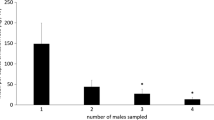Abstract
About equal numbers of each sex of flyingIps paraconfusus Lanier (Coleoptera: Scolytidae) were caught on traps several meters downwind from a male-infested ponderosa pine log releasing pheromone while a significantly different ratio of over four times more females than males were caught at the pheromone source. Females oriented directly to higher concentrations of colonizing males in a felled tree while males tended to land on the host in adjacent uncolonized areas. The attraction response of walking males to a 1∶1∶1 mixture of the synthetic pheromone components ispenol-ipsdienol-cis-verbenol was reduced progressively at higher concentrations while female response continued to increase. These responses may function to regulate density of colonization and limit intraspecific competition.
Similar content being viewed by others
References
Barr, B.A. 1969. Sound production in Scolytidae (Coleoptera) with emphasis on the genusIps.Can. Entomol. 101:636–672.
Bedasd, W.D., andBrowne, L.E. 1969. A delivery-trapping system for evaluating insect chemical attractants in nature.J. Econ. Entomol 62:1202–1203.
Bedard, W.D., Tilden, P.E., Wood, D.L., Lindahl, K.Q., andRauch, P.A. 1980a. Effects of verbenone andtrans-verbenol on the response ofDendroctonus brevicomis to natural and synthetic attractant in the field.J. Chem. Ecol. 6:997–1014.
Bedard, W.D., Wood, D.L., Tilden, P.E., Lindahl, K.Q. Jr., Silverstein, R.M., andRodin, J.O. 1980b. Field response of the western pine beetle and one of its predators to host and beetle produced compounds.J. Chem. Ecol. 6:625–641.
Birch, M.C., andWood, D.L. 1975. Mutual inhibition of the attractant pheromone response by two species ofIps (Coleoptera: Scolytidae).J. Chem. Ecol. 1:101–113.
Birch, M.C., Light, D.M., Wood, D.L., Browne, L.E., Silverstein, R.M., Bergot, B.J., Ohloff, G., West, J.R., andYoung, J.C. 1980. Pheromonal attraction and allomonal interruption ofIps pini in California by the two enantiomers of ipsdienol.J. Chem. Ecol. 6:703–717.
Borden, J.H. 1977. Behavioral responses of Coleoptera to pheromones, allomones, and kairomones, pp. 169–198,in H.H. Shorey, and J.J. McKelvy, Jr. (eds.).Chemical Control of Insect Behavior. John Wiley, New York.
Browne, L.E., Birch, M.C., andWood, D.L. 1974. Novel trapping and delivery systems for airborne insect pheromones.J. Insect Physiol. 20:183–193.
Byers, J.A. 1981a. Pheromone biosynthesis in the bark beetle,Ips paraconfusus, during feeding or exposure to vapours of host plant precursors.Insect Kochem. 11:563–569.
Byers, J.A. 1981b. Effect of mating on terminating aggregation during host colonization in the bark beetle,Ips paraconfusus.J. Chem. Ecol. 7:1135–1147.
Byers, J.A., andWood, D.L. 1980. Interspecific inhibition of the response of the bark beetlesDendroctonus brevicomis andIps paraconfusus to their pheromones in the field.J. Chem. Ecol. 6:149–164.
Byers, J.A., andWood, D.L. 1981. Interspecific effects of pheromones on the attraction of the bark beetles,Dendroctonus brevicomis andIps paraconfusus in the laboratory.J. Chem. Ecol. 7:9–18.
Byers, J.A., Wood, D.L., Browne, L.E., Fish, R.H., Piatek, B., andHendry, L.B. 1979. Relationship between a host plant compound, myrcene and pheromone production in the bark beetleIps paraconfusus.J. Insect Physiol. 25:477–482.
Cameron, E.A., andBorden, J.A. 1967. Emergence patterns ofIps confusus (Coleoptera: Scolytidae) from ponderosa pine.Can. Entomol. 99:236–244.
Furniss, M.M., Daterman, G.E., Kline, L.F., andRudinsky, J.A. 1974. Effectiveness of the Douglas-fir beetle antiaggregative pheromone methycyclohexenone at three concentrations and spacings around felled host trees.Can. Entomol. 106:381–392.
Gara, R.I. 1963. Studies on the flight behavior ofIps confusus (LeC.) (Coleoptera: Scolytidae) in response to attractive material.Contrib. Boyce Thompson Inst. 22:51–66.
Hedden, R.L., andPitman, G.B. 1978. Attack density regulation: a new approach to the use of pheromones in Douglas-fir beetle population management.J. Econ. Entomol. 71:633–637.
Hendry, L.B., Piatek, B., Browne, L.E., Wood, D.L., Byers, J.A., Fish, R.H., andHicks, R.A. 1980. In vivo conversion of a labelled host plant chemical to pheromones of the bark beetleIps paraconfusus.Nature 284:485.
Hughes, P.R. 1974. Myrcene: A precursor of pheromones inIps beetles.J. Insect Physiol. 20:1271–1275.
Hughes, P.R., andPitman, G.B. 1971. A method for observing and recording the flight behavior of tethered bark beetles in response to chemical messengers.Contrib. Boyce Thompson Inst. 24:329–336.
Klimetzek, D., Kiesel, K., andMohring, C. 1981.Trypodendron lineatum: reduction of pheromone response by male beetles.Naturwissenschaften 68:148–150.
Lanier, G.N., Birch, M.C., Schmitz, R.F., andFurniss, M.M. 1972. Pheromones ofIps pini (Coleoptera: Scolytidae): Variation in response among three populations.Can. Entomol. 104:1917–1923.
Lanier, G.N., Classon, A., Stewart, T., Piston, J.J., andSilverstein, R.M. 1980.Ips pini: The basis for interpopulational differences in pheromone biology.J. Chem. Ecol. 6:677–687.
Mendenhall, W. 1967. Introduction to Probability and Statistics. Wadsworth, Belmont, California.
Mustaparta, H., Angst, M.E., andLanier, G.N. 1980. Receptor discrimination of enantiomers of the aggregation pheromone ipsdienol, in two species ofIps.J. Chem. Ecol. 6:689–701.
Nijholt, W. W. 1973. The effect of maleTrypodendron lineatum (Coleoptera: Scolytidae) on the response of field populations to secondary attraction.Can. Entomol. 105:583–590.
Payne, T.L., Coster, J.E., Richerson, J.V., Edson, L.J., andHart, E.R. 1978. Field response of the southern pine beetle to behavioral chemicals.Environ. Entomol. 7:578–582.
Peacock, J.W., Lincoln, A.C., Simeone, J.B., andSilverstein, R.M. 1971. Attraction ofScolytus multistriatus (Coleoptera: Scolytidae) to a virgin-female-produced pheromone in the field.Ann. Entomol. Soc. Am. 64:1143–1149.
Pitman, G.B., andVité, J.P. 174. Biosynthesis of methylcyclohexenone by male Douglas-fir beetle.Environ. Entomol. 3:886–887.
Pitman, G.B., Kliefoth, R.A., andVité, J.P. 1965. Studies on the pheromone ofIps confusus (LeConte). II. Further observations on the site of production.Contrib. Boyce Thompson Inst. 23:13–17.
Renwick, J.A.A. 1967. Identification of two oxygenated terpenes from the bark beetlesDendroctonus frontalis andDendroctonus brevicomis.Contrib. Boyce Thompson Inst. 23:355–360.
Renwick, J.A.A., andVité, J.P. 1970. Systems of chemical communication inDendroctonus. Contrib.Boyce Thompson Inst. 24:283–292.
Renwick, J.A.A., Hughes, P.R., andKrull, I.S. 1976. Selective production ofcis- andtrans-verbenol from (−) and (+) alpha-pinene by a bark beetle.Science 191:199–201.
Rudinsky, J.A. 1973. Multiple functions of the southern pine beetle pheromone verbenone.Environ. Entomol. 2:511–514.
Rudinsky, J.A., andMichael, R.R. 1972. Sound production in Scolytidae: Chemostimulus of sonic signal by the Douglas-fir beetle.Science 175:1386–1390.
Rudinsky, J.A., Furniss, M.M., Kline, L.N., andSchmitz, R.F. 1972. Attraction and repression ofDendroctonus pseudotsugae (Coleoptera: Scolytidae) by three synthetic pheromones in traps in Oregon and Idaho.Can. Entomol. 104:815–822.
Rudinsky, J.A., Morgan, M.E., Libbey, L.M., andPutman, T.B. 1974. Additional components of the Douglas-fir beetle (Col., Scolytidae) aggregative pheromone and their possible utility in pest control.Z. Angew. Entomol. 76:65–77.
Silverstein, R.M., Rodin, J.O., andWood, D.L. 1966. Sex attractants in frass produced by maleIps confusus in ponderosa pine.Science 154:509–510.
Struble, G.R., andHall, R.C. 1955. The California five-spined engraver its biology and control. USDA Circular No. 964.
Tilden, P.E., Bedard, W.D., Wood, D.L., Lindahl, K.Q., andRauch, P.A. 1979. Trapping the western pine beetle at and near a source of synthetic attractive pheromone: Effects of trap size and position.J. Chem. Ecol. 5:519–531.
Vité, J.P., andPitman, G.B. 1969. Aggregation behaviour ofDendroctonus brevicomis in response to synthetic pheromones.J. Insect Physiol. 15:1617–1622.
Vité, J.P., Bakke, A., andRenwick, J.A.A. 1972. Pheromones inIps (Coleoptera: Scolytidae): occurrence and production.Can. Entomol. 104:1967–1975.
Wood, D.L. 1962. The attraction created by males of a bark beetleIps confusus (LeConte) attacking ponderosa pine.Pan-Pac. Entomol. 38:141–145.
Wood, D.L. 1972. Selection and colonization of ponderosa pine by bark beetles, pp. 101–117,in H.F. van Emden (ed.).Insect/ Plant Relationships. Blackwell Sci. Publ., Oxford.
Wood, D.L., andBushing, R.W. 1963. The olfactory response ofIps confusus (LeConte) (Coleoptera: Scolytidae) to the secondary attraction in the laboratory.Can. Entomol. 95:1066–1078.
Wood, D.L., Browne, L.E., Bedard, W.D., Tilden, P.E., Silverstein, R.M., andRodin, J.O. 1968. Response ofIps confusus to synthetic sex pheromones in nature.Science 159:1373–1374.
Wood, D.L., Browne, L.E., Ewing, B., Lindahl, K., Bedard, W.D., Tilden, P.E., Mori, K., Pitman, G.B., andHughes, P.R. 1976. Western pine beetle: specificity among enantiomers of male and female components of an attractant pheromone.Science 192:896–898.
Author information
Authors and Affiliations
Rights and permissions
About this article
Cite this article
Byers, J.A. Sex-specific responses to aggregation pheromone Regulation of colonization density in the bark beetleIps paraconfusus . J Chem Ecol 9, 129–142 (1983). https://doi.org/10.1007/BF00987777
Received:
Revised:
Issue Date:
DOI: https://doi.org/10.1007/BF00987777




